If I could tell the story in words, I wouldn't need to lug around a camera.
如果我能用言语来讲故事,我就不必拽上照相机了。
—Lewis Hine, American Photographer 美国摄影师刘易斯·海因
Photography can take us places we've never been before, perhaps never dreamed of. There are some photographs that will make you stop and think. These six photographs stopped the world and people hold their breaths for a few seconds to take it all in.
摄影作品可以把我们带到从未去过的地方,甚至是做梦都想不到的地方。有些照片会让你停下脚步,凝神思考。下面这六张照片就曾令全世界的人们伫足,屏息,凝视,思考。
The Photograph That Raised the Stakes
一张增加了新闻摄影风险的照片
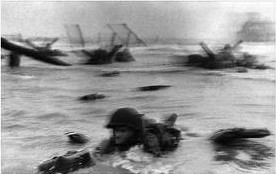 “If your pictures aren't good enough,” war photographer Robert Capa used to say, “you aren't close enough.” Words to die by, yes, but the man knew of what he spoke. After all, his most memorable shots were taken on the morning of D-Day1), June 6, 1944, when he landed alongside the first waves of infantry2) at Omaha Beach.
“If your pictures aren't good enough,” war photographer Robert Capa used to say, “you aren't close enough.” Words to die by, yes, but the man knew of what he spoke. After all, his most memorable shots were taken on the morning of D-Day1), June 6, 1944, when he landed alongside the first waves of infantry2) at Omaha Beach.
战地摄影记者罗伯特·卡帕有过一句名言:“如果你的照片拍得不够好,那是因为你离炮火不够近。”说这种话,不是找死吗?没错,不过他清楚自己说的是什么。毕竟,他最令人难忘的那组镜头就是在诺曼底登陆日(1944年6月6日)的早晨拍摄下来的,当时,他与第一批步兵一起登陆奥马哈海滩。
Caught under heavy fire, Capa dove for what little cover he could find, then shot all the film in his camera, and got out—just barely. He escaped with his life, but not much else. Of the four rolls of film Capa took of the horrific D-Day battle, all but 11 exposures were ruined by an overeager lab assistant, who melted the film in his rush to develop it.
登陆当天,炮火异常猛烈,卡帕好不容易找到了一个掩体,一头扎过去,等拍完了相机里的全部胶卷才出来,险些把命丢在掩体后面。他死里逃生,捡回了一条命,但除了那条命,带回来的其他东西并不多。关于那场可怕的诺曼底登陆战役,卡帕一共拍了四卷胶卷,但除了11张外,余下的全都叫一个过于心切的助手给毁了,他手忙脚乱地冲洗胶卷时,把胶卷给溶化掉了。
In an ironic twist, however, that same mistake gave the few surviving exposures their famously surreal3) look (“slightly out of focus,” Life incorrectly explained upon printing them). More than 50 years later, director Steven Spielberg4) would go to great lengths to reproduce the look of that “error” for his harrowing D-Day landing sequence in Saving Private Ryan.
不过,颇具讽刺意味的是,这一错误却给这几张仅存的照片带来了极佳的超现实主义视觉效果(《生活》杂志在刊印这些照片时,将其错误地解释为“对焦稍微有点失准”)。五十多年后,电影导演史蒂文·斯皮尔伯格在拍摄《拯救大兵瑞恩》时,为了拍摄诺曼底登陆这一让人心惊胆战的场景,还不遗余力地刻意复制这一“错误”所导致的视觉效果。
The Photograph That Gave a Face to the Great Depression
一张展现经济大萧条“面貌”的照片
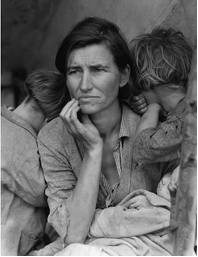 For many, Florence Owens Thompson is the face of the Great Depression. Lange captured the image while visiting a dusty California pea-pickers' camp in February 1936, and in doing so, captured the resilience of a proud nation facing desperate times.
For many, Florence Owens Thompson is the face of the Great Depression. Lange captured the image while visiting a dusty California pea-pickers' camp in February 1936, and in doing so, captured the resilience of a proud nation facing desperate times.
对很多人来说,弗洛伦斯·欧文斯·汤普森的这张脸是经济大萧条时期的典型代表。1936年2月,兰格在参观加利福尼亚州一尘土飞扬的豌豆采摘营地时,捕捉到了这一镜头,与此同时,也捕捉到了一个自豪的民族在面临绝境时的适应力。
Unbelievably, Thompson's story is as compelling as her portrait. Thompson was a mother of seven who'd lost her husband to tuberculosis5). Stranded at a migratory labor farm in Nipomo, Calif. her family sustained themselves on birds killed by her kids and vegetables taken from a nearby field—as meager6) a living as any earned by the other 2,500 workers there. The photo's impact was staggering. Reproduced in newspapers everywhere, Thompson's haunted face triggered an immediate public outcry, quickly prompting politicos7) from the federal Resettlement Administration to send food and supplies. Sadly, however, Thompson and her family had already moved on, receiving nary8) a wedge of government cheese for their high-profile misery. In fact, no one knew the identity of the photographed woman until Thompson revealed herself years later in a 1976 newspaper article.
难以置信的是,汤普森的经历和她的照片一样引人瞩目。她是七个孩子的母亲,丈夫死于肺结核,一家八口困在加州尼波莫的一个流浪劳工农场,和住在这里的2500名工人一样,过着吃了上顿没下顿的生活,一家人靠着孩子打的鸟和从附近的野地里挖的野菜聊以糊口度日。这张照片产生了惊人的影响。各地报纸纷纷转载,汤普森那张饱经沧桑、历经磨难的脸立即引起了公众的强烈反响,促使联邦安置局的政客们迅速送去了食物和日常用品。然而,令人遗憾的是,汤普森一家早已踏上了新的逃荒之路,他们的悲惨处境虽备受瞩目,但却连政府的奶酪都没得到一块。事实上,当时并没有人知道照片上这名妇女的身份,直到多年之后,汤普森才在1976年的一份报纸刊登的文章中公开了自己的身份。
The Photograph That Ended a War but Ruined a Life
一张结束了一场战争却毁掉了一个人一生的照片
Adams' 1968 photograph of an officer shooting a handcuffed prisoner in the head at point-blank range not only earned him a Pulitzer Prize in 1969, but also went a long way toward souring Americans' attitudes about the Vietnam War. 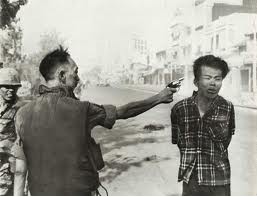 这是亚当斯1968年拍摄的一张照片,照片中,一名警官正用枪对准一个带手铐的囚犯的头部,准备近距离射击。该照片不仅为他赢得了1969年的普利策奖,还极大地助长了美国人反越战的情绪。
这是亚当斯1968年拍摄的一张照片,照片中,一名警官正用枪对准一个带手铐的囚犯的头部,准备近距离射击。该照片不仅为他赢得了1969年的普利策奖,还极大地助长了美国人反越战的情绪。
For all the image's political impact, though, the situation wasn't as black-and-white as it's rendered. What Adams' photograph doesn't reveal is that the man being shot was the captain of a Vietcong “revenge squad” that had executed dozens of unarmed civilians earlier the same day. Regardless, it instantly became an icon of the war's savagery and made the official pulling the trigger—General Nguyen Ngoc Loan—its iconic villain.
虽然这张照片有着巨大的政治影响,但实际情况并非像照片本身所表现的那样黑白分明。亚当斯的这张照片并未透露的一点是,这个被枪决的男子是一个越共“复仇队”的队长,就在当天早些时候,他处死了数十名手无寸铁的平民。可是不管怎样,这张照片立刻成为了战争残酷性的标志,也使得这位扣动扳机的警官—阮玉湾将军—成了标志性的战争恶棍。
Sadly, the photograph's legacy would haunt Loan for the rest of his life. Following the war, he was reviled wherever he went. After an Australian VA9) hospital refused to treat him, he was transferred to the United States, where he was met with a massive campaign to deport him. He eventually settled in Virginia and opened a restaurant but was forced to close it down as soon as his past caught up with him. Vandals10) scrawled “we know who you are” on his walls, and business dried up.
可悲的是,这张照片给阮玉湾的余生留下了挥之不去的影响。战争结束后,他走到哪儿都能听到骂声一片。一家澳大利亚退伍军人管理署的医院拒绝给他治疗,于是将他转移到了美国,而在那里,迎接他的是一场要求将他驱逐出境的大规模抗议活动。最后,他好不容易在弗吉尼亚落了脚,开了家餐馆,可很快就被迫关张了,因为他的过去就像阴魂一样缠住了他。一些故意跟他过不去的人在墙上潦草地写满了“我们知道你是谁”,生意也就黄了。
Adams felt so bad for Loan that he apologized for having taken the photo at all, admitting, “The general killed the Vietcong; I killed the general with my camera.”
亚当斯对阮玉湾的遭遇深感难过,为自己拍了那张照片而道了歉,他承认:“将军用枪杀死了那名越共分子,而我却用相机毁掉了将军的一生。”
The Photograph That Isn’t as Romantic as You Might Think
一张不像你想的那么浪漫的照片
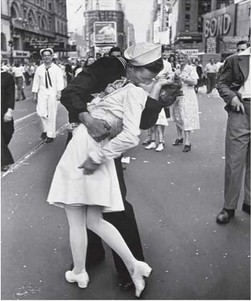 On August 14, 1945, the news of Japan's surrender was announced in the United States, signaling the end of World War II. Riotous celebrations erupted in the streets, but perhaps none were more relieved than those in uniform.
On August 14, 1945, the news of Japan's surrender was announced in the United States, signaling the end of World War II. Riotous celebrations erupted in the streets, but perhaps none were more relieved than those in uniform.
1945年8月14日,美国宣布了日本投降的消息,这标志着第二次世界大战的结束。大街小巷顿时变成了一片狂欢喜庆的海洋,但最感宽慰的恐怕还是那些身着制服的军人了。
Among the overjoyed masses gathered in Times Square that day was one of the most talented photojournalists of the 20th century, a German immigrant named Alfred Eisenstaedt. While snapping pictures of the celebration, he spotted a sailor “running along the street grabbing any and every girl in sight.” He later explained that, “whether she was a grandmother, stout11), thin, old, didn't make any difference.”
当天,聚集在时代广场的欣喜若狂的人群中,有一个叫艾尔弗雷德·艾森斯塔特的德国移民,他是20世纪最有才华的摄影记者之一。在抓拍欢庆的镜头时,他发现一名水手“沿街奔跑,每碰见一个女性就上去拥抱,不放过任何一个”。 他后来解释说,“其实不管对方年老年幼,也不论高矮胖瘦,他都上前与之拥抱。”
Of course, a photo of the sailor planting a wet one on a senior citizen wouldn't have made the cover of Life, but when he locked lips with an attractive nurse, the image was circulated in newspapers across the country. In any case, the image remains an enduring symbol of America's exuberance at the end of a long struggle.
当然,如果该水手吻的是一个老太婆的话,那拍下的照片也就不会登上《生活》杂志的封面了,但他恰恰是在和一个年轻貌美的护士相吻,所以这张照片就在全国各大报纸上流传开了。不管怎么说,这张照片依然是美国人在结束一场长期斗争时欢喜若狂的永久象征。
The Photograph That Kept Che Alive
一张使切·格瓦拉永生的照片
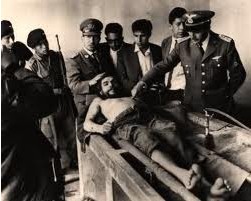 Sociopathic13) thug? Socialist luminary14)? Or as existentialist Jean-Paul Sartre15) called him, “the most complete human being of our age?” Whatever you believe, there's no denying that Ernesto Che Guevara has become the patron saint of revolutionaries.
Sociopathic13) thug? Socialist luminary14)? Or as existentialist Jean-Paul Sartre15) called him, “the most complete human being of our age?” Whatever you believe, there's no denying that Ernesto Che Guevara has become the patron saint of revolutionaries.
他是反社会的暴徒?是社会主义的杰出人物?还是像存在主义者让-保罗·萨特所评价的那样,是“我们这个时代拥有最完整人格的人”?不管你相信哪一种说法,有一点是不可否认的,那就是埃内斯托·切·格瓦拉已成为革命者的守护神。
Annoyed by his efforts to incite revolution among the poor and oppressed in Bolivia, the nation's army captured and executed Guevara in 1967. But before dumping his body in a secret grave, they gathered around for a strategic photo op16). They wanted to prove to the world that Che was dead, in hopes that his political movement would die with him.
由于切·格瓦拉在玻利维亚致力于鼓动受压迫的贫苦大众起来革命,玻利维亚军队愤怒不已,于1967年将之抓获,并予以处决。但在把他的尸体埋入一个秘密坟墓之前,他们特意聚在一处给媒体提供了一个拍照的机会。他们想向世界证明切·格瓦拉已经死了,希望他领导的政治运动也随着他的一命呜呼而呜呼哀哉。
But by killing the man, Bolivian officials unwittingly birthed his legend. The photo, which circulated around the world, bore a striking resemblance to Renaissance paintings of Christ taken down from the cross. Even as Che's killers preened17) and gloated18) above him (the officer on the right seems to be inadvertently pointing to a wound on Guevara's body near where Christ's final wound was inflicted), Che's eerily peaceful face was described as showing forgiveness. The photo's allegorical significance certainly wasn't lost on the revolutionary protesters of the era. They quickly adopted “Che lives!” as a slogan and rallying cry.
然而事与愿违,玻利维亚官员杀死了格瓦拉,却无意中造就了他的传奇。这张在全世界广为流传的照片,与文艺复兴时期的油画作品——从十字架上取下来的耶稣——有着惊人的相似之处。杀死格瓦拉的刽子手们站在一旁,洋洋自得、幸灾乐祸(站在右边的军官似乎正不经意地指着格瓦拉身上的一处伤口,那伤口的位置与耶稣最终受难时受伤的位置非常接近),相比之下,格瓦拉则神情安详,大有表示宽恕的意思。那个时代的革命抗议者自然能够领会照片的寓意,迅速喊出了 “格瓦拉万岁!”的战斗口号。
The Photograph That Allowed Geniuses to Have a Sense of Humor
一张让天才有了幽默感的照片
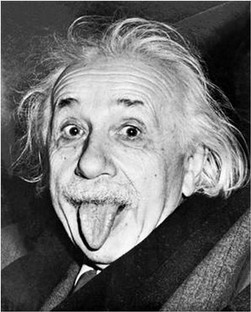 While Einstein certainly changed history with his contributions to nuclear physics and quantum mechanics, this photo changed the way history looked at Einstein. By humanizing a man known chiefly for his brilliance, this image is the reason Einstein's name has become synonymous not only with “genius”, but also with “wacky genius”.
While Einstein certainly changed history with his contributions to nuclear physics and quantum mechanics, this photo changed the way history looked at Einstein. By humanizing a man known chiefly for his brilliance, this image is the reason Einstein's name has become synonymous not only with “genius”, but also with “wacky genius”.
爱因斯坦在核物理和量子力学领域的贡献无疑改变了历史,而这张照片却改变了历史对爱因斯坦的看法。这张照片让一个主要以才华著称的人有了人情味,从而使得爱因斯坦这个名字不仅成为“天才”的代名词,也成为“怪才”的代名词。
So why the history-making tongue? It seems Professor Einstein, hoping to enjoy his 72nd birthday in peace, was stuck on the Princeton campus enduring incessant19) hounding by the press. Upon being prodded to smile for the camera for what seemed like the millionth time, he gave photographer Arthur Sasse a good look at his uvula instead. This being no ordinary tongue, the resulting photo became an instant classic, thus ensuring that the distinguished Nobel Prize-winner would be remembered as much for his personality as for his brain.
那么这一创造历史的舌头是怎么回事呢?事情似乎是这样的:爱因斯坦教授本想安安静静地庆贺自己的72岁生日,却因记者的纠缠不休而无法从普林斯顿大学校园脱身。在镜头前微笑了无数次之后,爱因斯坦实在是受够了,于是,在面对摄影师亚瑟·赛西时,他不再展露微笑,而是吐了一下舌头。这可不是一般的舌头,由它所成就的照片旋即成为经典,从而使得这位杰出诺贝尔奖得主的人格魅力也像他才华横溢的大脑一样留在了人们的记忆之中。
1. D-Day:美国军事用语,进攻发起日,尤指第二次世界大战中的盟国在西欧诺曼底登陆的那天,即1944年6月6日。
2. infantry [ˈɪnfəntrɪ] n. 步兵,步兵团
3. surreal [səˈrɪəl] adj. 超现实主义的
4. Steven Spielberg:史蒂文·斯皮尔伯格(1946~),美国著名电影导演、编剧和电影制作人,曾两度荣获奥斯卡最佳导演奖,著名的代表作品有《大白鲨》(Jaws)、《外星人》(E.T. the Extra-Terrestrial)、《辛德勒的名单》(Schindler's List)等。
5. tuberculosis [tjuːˌbɜː(r)kjʊˈləʊsɪs] n. 肺结核
6. meager [ˈmiːɡə(r)] adj. 不足的,缺乏的,贫乏的
7. politico [pəˈlɪtɪkəʊ] n. 政客
8. nary [ˈneəri] adj. 一个也没有的
9. VA:退伍军人管理署(Department of Veterans Affairs的缩写)
10. vandal [ˈvænd(ə)l] n. 故意破坏者,破坏别人财产者
11. stout [staʊt] adj. 矮胖的
12. Che Guevara:切·格瓦拉(1928~1967),出生于阿根廷的罗萨里奥,马克思主义革命者和古巴游击队领导人。他在卡斯特罗领导的古巴革命中扮演着重要角色。被捕入狱后,他成为第三世界共产革命运动中的英雄和西方左翼运动的象征。
13. sociopathic [ˈsəʊʃɪəʊˌpæθɪk] adj. 反社会的
14. luminary [ˈluːmɪnərɪ] n. 名人,杰出人物
15. Jean-Paul Sartre:让-保罗·萨特(1905~1980),法国20世纪最重要的哲学家之一,法国无神论存在主义的主要代表人物,代表作有《存在与虚无》(Being and Nothingness)等。
16. photo op:亦写作photo opp,是photo opportunity的缩写,意思是“拍照机会;(名人政要等)接受媒体拍照的时间”。
17. preen [priːn] vi. 自负,自满
18. gloat [ɡləʊt] vi. 洋洋得意,幸灾乐祸
19. incessant [ɪnˈses(ə)nt] adj. 不断的,不停的
